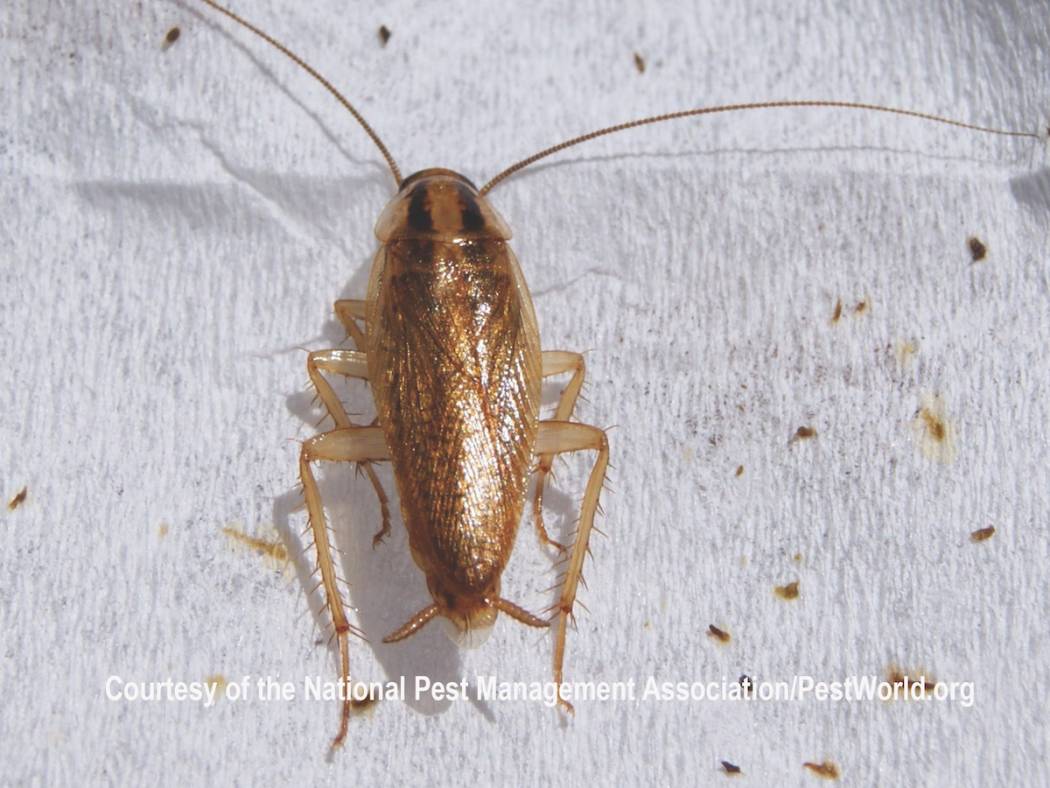How to Get Rid of German Cockroaches

The German cockroach (Blatella germanica) is a small species of cockroach that can infest homes, restaurants, hotels and other human dwellings. It is the most common cockroach species worldwide and can pose a serious health hazard. In this article, we will discuss the appearance, behavior, diet, reproduction, dangers and prevention tips of the German cockroach.
Appearance
The German cockroach is about 1.2 to 1.6 centimeters long and light brown to tan in color. It has two dark parallel streaks on its back, right behind its head. Both males and females have fully grown wings, but they seldom fly and prefer to run. The nymphs (the babies) look like smaller versions of their parents but don’t yet have wings. They are slightly darker in color, ranging from dark brown to black.
Behavior
The German cockroach is an omnivorous creature that can eat anything from food scraps to pet food and even book bindings. It prefers warm and humid places close to a constant food source, which is why it is often found in bathrooms and kitchens. It is also very adaptable and can survive in harsh conditions such as high temperatures, low humidity and lack of food.
The German cockroach is a nocturnal insect that hides during the day and comes out at night to feed. It can squeeze into cracks and crevices as small as 1/16 inch wide. It is also very fast and can run up to 3 miles per hour. It can also climb on smooth surfaces such as glass and metal.
Diet
The German cockroach has a varied diet that includes both plant and animal matter. It can feed on starches, sugars, fats, meats, cheeses, grains, fruits, vegetables and more. It can also scavenge on dead insects, feces, hair, nails and other organic debris.
The German cockroach has a high metabolic rate and needs to eat frequently. It can consume up to 40% of its body weight per day. It can also survive for up to a month without food if water is available.
Reproduction
The German cockroach has a very high reproductive potential and can quickly multiply in numbers. The female cockroach carries eggs in an egg case (called an ootheca) until just before they are about to hatch. Each egg case contains roughly 30 to 40 eggs. The female can produce up to eight egg cases in her lifetime, resulting in as many as 400 offspring.
The eggs hatch in about a month and the nymphs go through six to seven molts before reaching adulthood. The nymphs look like miniature adults but are wingless and darker in color. The nymphal stage lasts for about two months under optimal conditions.
Dangers
The German cockroach is a serious pest that can cause various problems for humans. Some of the dangers of the German cockroach are:
-
- Contaminating food or food products with their feces and defensive secretions
-
- Spreading diseases such as salmonella, E. coli, typhoid fever, dysentery and more
-
- Triggering allergic reactions such as asthma, skin rashes, sneezing and itching
-
- Biting humans and feeding on food residues on the faces of sleeping humans (in extremely heavy infestations)
-
- Damaging books, papers, fabrics and other materials with their chewing
Prevention Tips
The best way to prevent a German cockroach infestation is to eliminate their food, water and shelter sources. Some of the prevention tips are:
-
- Keep your kitchen clean and tidy. Store food in sealed containers and dispose of garbage regularly.
-
- Fix any leaks or drips in your plumbing system. Eliminate any standing water or moisture sources.
-
- Seal any cracks or gaps in your walls, floors or ceilings. Use caulk or steel wool to block their entry points.
-
- Vacuum your carpets and floors regularly. Remove any clutter or debris that can provide hiding places for the roaches.
-
- Use pest control methods such as baits, traps or sprays to kill or repel the roaches. Follow the instructions carefully and use them safely.
-
- Hire a professional pest control service if the infestation is severe or beyond your control.
The German cockroach is a common and annoying pest that can infest your home or business. It can cause health problems, damage your property and create a nuisance. By following the prevention tips above, you can reduce the chances of having a German cockroach problem. If you need professional help, contact a pest control company that can offer effective and safe solutions.
Frequently Asked Questions About German Cockroaches
-
How to Get Rid of CockroachesQuestions people ask about cockroaches
-
What are the natural pest control methods for German cockroaches?Some of the natural pest control methods for German cockroaches are using boric acid, diatomaceous earth, baking soda, vinegar, essential oils or herbs that repel roaches. These methods are less toxic and more eco-friendly than chemical pesticides, but they may not be as effective or fast-acting.
-
How can I tell the difference between a German cockroach and an Asian cockroach?The German cockroach and the Asian cockroach are very similar in appearance and can be hard to tell apart. However, there are some subtle differences that can help you identify them. The Asian cockroach is slightly smaller and lighter in color than the German cockroach. It also has longer wings and can fly well, unlike the German cockroach. The Asian cockroach is more active during the day and prefers outdoor habitats, while the German cockroach is nocturnal and prefers indoor habitats.
-
How long can a German cockroach live without its head?A German cockroach can live without its head for up to a week. This is because it does not need its brain to breathe, circulate blood or digest food. It only needs its brain to sense light, smell and movement. However, without its head, it will eventually die of dehydration or starvation.
-